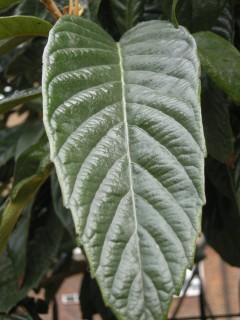Position: Full sun
Flowering period: Late summer to winter
Soil: Well drained
Eventual Height: 10m
Eventual Spread: 8m
Hardiness: 7a, 7b, 8a, 8b, 9a, 9b, 10a, 10b, 11
Family: Rosaceae
Eriobotrya japonica is an evergreen, fruiting, large shrub or small tree with a rounded habit. Its leaves are alternate, simple, up to 25cm long, deeply veined and leathery in texture. They are dark green above and velvety below. The young leaves are covered in a velvety hairs which disappears with age. The white fragrant hermaphrodite flowers are borne in large stiff panicles of three to ten, they are 2cm in diameter with 5 petals. The yellow/ orange fruits of the plant are spherical to pear shaped, growing in clusters of up to 5cm long and ripen the following winter after the flowers. The root system of the plant is quite shallow.
Eriobotrya japonica, commonly known as the Loquat, Japanese plum or Chinese plum, is native to southeastern China. The plant was introduced into the United Kingdom, Royal Botanical Gardens at Kew, by Sir Joseph Banks in 1787. The plant was introduced into Japan and has been cultivated there for over 1000 years. This plant is now naturalised in Japan, India, Pakistan and he Mediterranean basin.
The etymological root of the binomial name Eriobotrya is derived from the Greek erion ‘wool’ and botrus ‘bunch of grapes’, alluding to the downy flower clusters. Japonica is derived from the Latin meaning of Japan.
The landscape architect may find Eriobotrya japonica useful as a small evergreen fruiting tree with fragrant flowers and large bold leaves. It may be useful in community or wildlife gardens due to its edible fruits. Once established this plant is drought tolerant. This tree may produce a lot of fruit, if left un-harvested they will fall to the ground .
Ecologically, Eriobotrya japonica is attractive to birds and bat for its fruit.
The Royal Horticultural Society has given Eriobotrya japonica their prestigious Award of Garden Merit in 1993.
Eriobotrya japonica prefers moist, fertile, well-drained soils. It will tolerate most pH of soil.
Eriobotrya japonica requires little maintenance.







Leave a comment